Types of brick stoves for the home: types of units by purpose and design features
A wood-burning stove in a country house or country cottage can be a more than useful acquisition.It is completely autonomous from external networks. Where electricity is often cut off and centralized gas supply is still not implemented, people cook with wood and heat the house with it.
If you decide to provide your home with such a useful device, it won’t hurt to study the types of brick stoves for your home in order to choose the most convenient, efficient and practical option.
We offer you to understand the traditional design of the furnace, the design and operational features of various heating and cooking units, as well as learn the methods and specifics of arranging a smoke circulation system.
The content of the article:
Structural components of furnaces
Any brick oven consists of the main elements:
- foundation - the base on which a brick unit rests, weighing several tons;
- array - part of the stove, including cooking and combustion chambers, a system of smoke channels - smoke circuits, a ash pan with a grate;
- chimney - a chimney pipe rising above the stove mass.
The foundation for such a bulky and heavy structure is arranged separately from the main foundation of the house.
If there is a strip or column base under the building, you need to make sure that it does not come into contact with the foundation of the stove. This will avoid the occurrence of deformations from an unevenly distributed load, because under a brick unit it will be much higher.
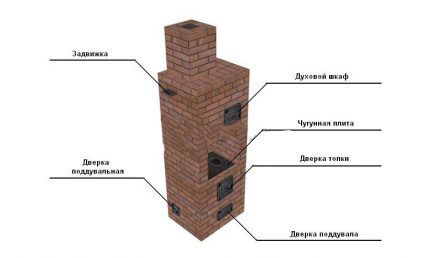
Monolithic foundations in private houses, especially small ones, are rare. If there is one, the stove can be installed directly on it. It is best to include the construction of such an object in the overall project in advance. When the house is already ready, the appearance of such additional load should be agreed upon with an experienced engineer.
The base of the furnace separates the combustion or gas chamber from the foundation. These are several rows of solid brickwork, which heat up and release some of the heat to the room, and also protect the base from overheating.
Above the base they make what is called a firebox. Below, under the combustion chamber, there is a small cavity - an ash pan. Above it is the actual firebox, in which the fuel burns. The blower and firebox are separated by a grate made of durable cast iron.
The firewood is placed directly on this grate. Through the blower and grate, the air necessary for combustion enters the fuel. At the same time, the necessary draft is created to remove smoke gases through the chimney system. But its design depends on what type of brick oven was chosen for the house.
The device can also be supplemented with elements such as a hob and oven. There are options for stoves with drying chambers and even with warm beds. Understanding the principles of the structure and operation of such a structure will help you choose the right type of stove, as well as resolve issues related to its construction.
Various functional purposes
First you need to decide on the functions that the device will perform.
This could be a stove:
- only for cooking;
- exclusively for heating the house;
- to perform both of these functions, i.e. combined option.
Cooking oven Most often they are installed in small free-standing kitchens. The heat from burning wood is abundantly enough not only for cooking, but also for heating such a room.

Therefore, the device is placed next to two external walls so that excess thermal energy moves outside. In this case, the chimney is strictly vertical and small in size.
Heating stove. The design provides for maximum retention of thermal energy within the house. Such a device has neither a stove nor an oven, but the oven array is equipped with an extensive smoke circulation system.
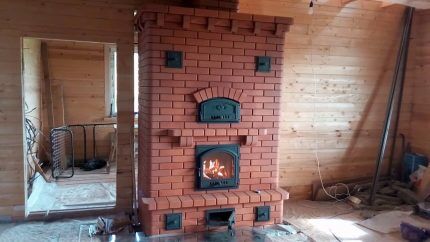
A bulky chimney is necessary so that combustion products do not leave the house too quickly and have time to heat the brickwork, which then gives off heat to the air inside the premises. Such a stove is placed as close to the center of the house as possible so that individual rooms are heated evenly.
Detailed information about the installation of stove heating in a private house is presented in this article.
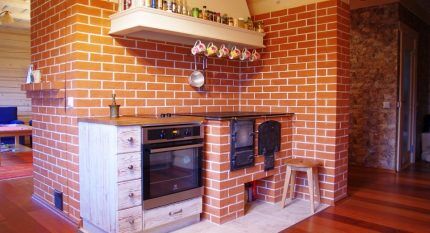
Combination oven. For its installation, both a hob and a branched chimney are used.They place it in the kitchen, but not near the outer walls, but next to the inner ones. The chimney is also, if possible, shifted towards the living rooms in order to provide them with sufficient heat.
Types of heating and cooking stoves
Story wood stove dates back centuries, if not millennia. In different countries, the best models have received well-deserved distribution.
Such designs are still used today, both in their classic form and with some additions.
Russian stove: complex and effective
The traditional Russian stove is a large, versatile device. Although there is no cast iron cooktop, you can cook food on it. The massive body perfectly warms the room, and in the upper part there is a warm bed.
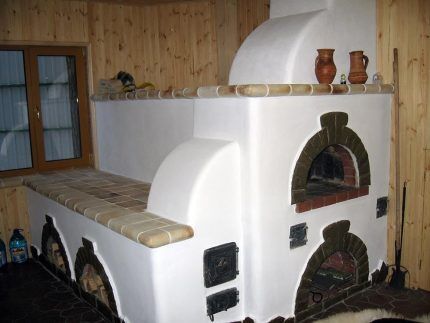
The long firebox is divided into two zones: the bakery, located in the front part, and the firebox, where the wood is burned. This oven operates in two modes. First, it is heated for some time. During this period, the device accumulates heat. After this, the heated stove glows for about a day, slowly releasing thermal energy.
During this period, in the bakery you can prepare various dishes with that unique taste that no other cooking unit can give them. The characteristics of the Russian stove are determined by the special nature of the movement of air flows inside the device.
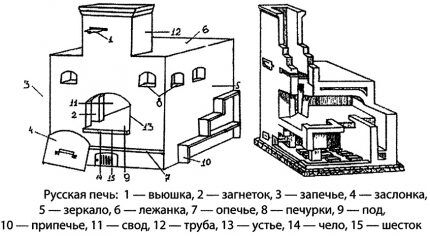
In front of the fuel chamber there is a so-called bend, the area above it is called the overpipe, and even higher there is a tapering top - hailo.
Thanks to this device, a recovery zone is formed in the combustion chamber, where the smoke coming out of the firebox heats up the oncoming flow of fresh air. In this case, the flows do not mix, oxygen enters the furnace in full.
The arrangement of the fuel chamber is also unusual. The bottom of the firebox is uneven; it is laid out with a rise relative to the cooking chamber. The upper arch is also not horizontal, it is higher in the rear, lowers closer to the mouth and ends with a threshold.
Between the base Russian stove and its fuel chamber is made into a long cavity called a chamber. It is always warm here; it is often used for storing firewood. In such conditions, the fuel dries well, it burns faster and transfers heat better.
On our website there is a block of articles devoted to the independent construction of different models of Russian stoves, we recommend that you read:
- Russian stove with stove: technology for laying a Russian stove with diagrams and detailed orders
- DIY mini Russian stove: specifics and procedures for building a compact stove
- Do-it-yourself Russian stoves with a stove bench: construction manuals with diagrams and procedures
“Dutch” - a simple heating unit
The Dutch stove was originally created for heating. It differs from the traditional Russian one in a simpler and easily modernized design.The design and dimensions can vary depending on the situation, for example, the size of the house.
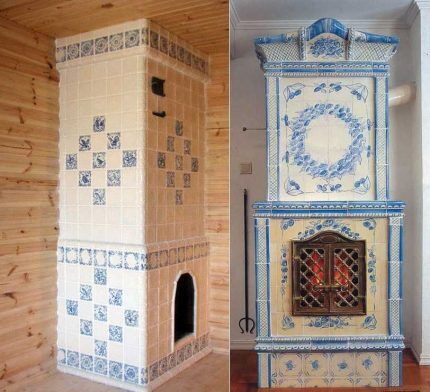
At the bottom there is a combustion chamber, at the top there is an extensive network of smoke circuits, including several vertical channels connected to each other by horizontal jumpers. As a result, the path along which smoke travels is lengthened, and heat remains in the house.
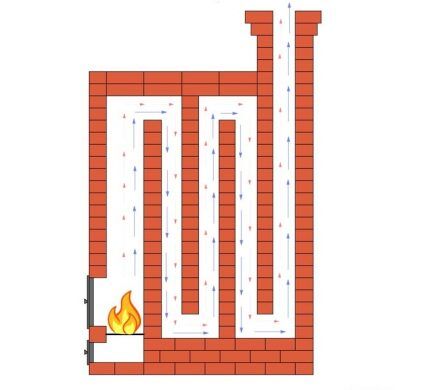
In modern versions, the “Dutch” is also supplemented with a hob, but initially the hearth was installed separately for these purposes.
Inexperienced stove makers are advised to start practicing on this type of stove, since it is quite difficult to damage it.
Swedish oven: an interesting combination option
Another interesting option for a novice master is a Swedish stove. Its design was developed by Swedish scientists not so long ago, in the middle of the 18th century. They took the Dutch one as a basis and greatly improved it.
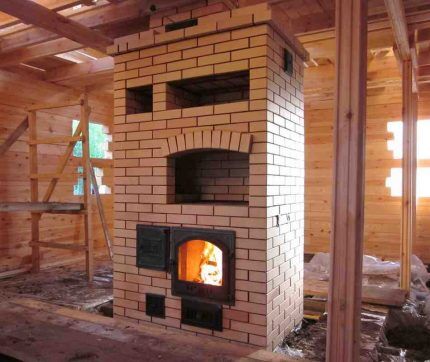
The lower part of such a stove is wider; at the bottom, in addition to the combustion chamber, there is an oven installed on the side. As a result, the first heat from fuel combustion does not escape through the chimney duct, but works to warm up the oven. If you open it, the heat will warm the floor and rise up.
The firebox itself is a version of a simplified bell, where both primary combustion of fuel and chemical secondary combustion take place. A niche is made in the upper part of the structure, which was traditionally used for drying clothes that got wet during the day.
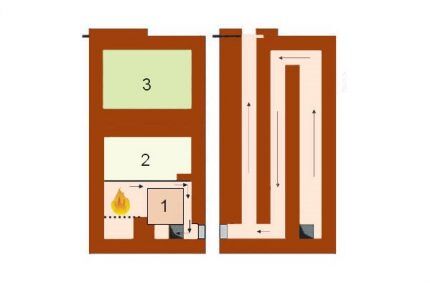
An oven installed on the side of the firebox quickly accumulates primary heat. The cabinet above the stove was used to store food prepared in the evening; by morning it remained warm and quickly reheated in the oven.
The vertical system of smoke circulation channels warms up the house well, but when the firebox is open, the heat quickly evaporates; you just need to remember to cover it after firing.
This stove is heated twice a day. The efficiency of the “Swedish” stove is almost as high as that of the Russian stove, while folding it is easier, cheaper, and it takes up less space. But high efficiency is achieved through accurate calculations, so during laying you will have to strictly observe the dimensions and proportions.
Smoke circulation options for brick stoves
The efficiency of a wood-burning stove largely depends on the type of its chimney. Properly organized movement of smoke gases allows you to retain heat and effectively remove fuel combustion products without endangering the health of the occupants of the house.
This design could be:
- with horizontal channels;
- with vertical channels;
- combined.
Based on the direction of movement of flue gases, stoves with smoke circulation are divided into direct-flow and counter-flow. In the second option, the smoke, before flying out into the chimney, makes several revolutions inside one of the smoke chambers.At this time he is moving in two different directions.
System with horizontal channels used infrequently. It heats the oven more evenly, but for each horizontal level you will have to make a cleaning door. A modification of such a chimney can be an option with pockets. These cavities will trap smoke for some time and increase the efficiency of the stove.
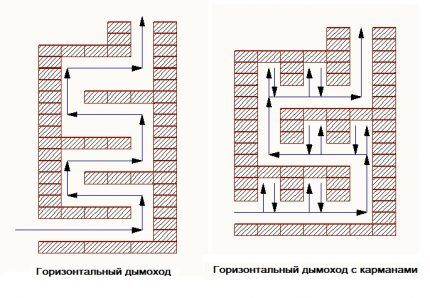
Vertical channel. The operating principle of such a chimney was described above as a characteristic feature of a “Dutch” stove. In such a system, less soot accumulates and is easier to clean.
But here the resistance to the movement of the smoke flow increases, so it is necessary to make such a chimney long enough to ensure normal draft. In the vertical version, the first channel warms up more than the others.
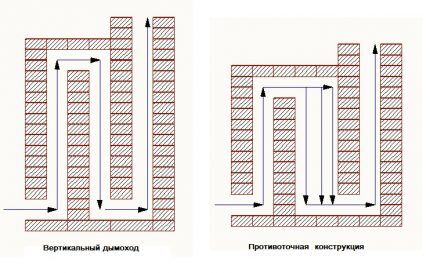
This temperature difference can cause damage to the masonry. To improve the situation, you can arrange a cross-flow option, in which the middle channel is made much wider than the outer ones. The cross section here will be larger, this will slow down the flow rate and make heating more uniform.
Bell furnace - an alternative to a design with vertical and horizontal smoke circulations. Instead of channels, there is a spacious cavity in which smoke accumulates and, after cooling, moves down and leaves through the chimney. Even after complete combustion of the fuel, the gases in the bell continue to give off heat.
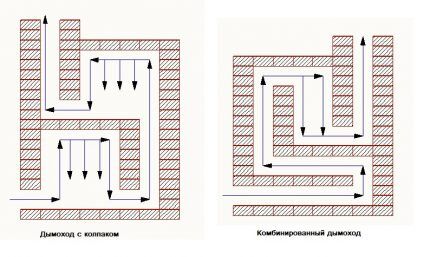
Unlike a vertical smoke circulation system, there is no danger of the gases quickly blowing out and the stove cooling down. The dimensions and configuration of the cap may vary.
When designing a stove, you can combine hoods with vertical chimney elements to obtain an effective design and increase efficiency.
Conclusions and useful video on the topic
Traditional Russian stove:
Heating stove - “Swedish”:
Small “Dutch”:
Brick stoves are very diverse; you can always choose or design an option that is suitable for specific conditions. The common requirement for all models is accurate calculation, use of quality materials and proper operation.
Do you have anything to add or have questions about choosing a brick stove for your home? You can leave comments on the publication, participate in discussions and share your own experience of using stove heating. The contact form is located in the lower block.




There is a Dutch woman in our house. With ever-increasing gas prices, this is a good option. Our utilities used to eat up half of our family budget. We have already seen that it is much more economical. But we didn’t decorate it with tiles. Painted with simple water-dispersion paint. When you heat the stove, no smell arises, and even surface unevenness is not so noticeable to the eye.
I have long had a desire, and maybe even a dream, to make a real Russian stove with a bench at the dacha, on which you can relax, almost like Ilya Muromets. The only thing that stops me is the decent price for its masonry. And it’s probably not possible to do it yourself either. And I don’t see any downsides to her at all, she’s got all the upsides. And it heats well and for a long time, and you can cook. It’s not for nothing that our ancestors did this.
Whatever one may say, the Russian stove also has disadvantages. First of all, it takes up a lot of space and is demanding on the foundation. As a good rule, the foundation for the stove should be laid along with the foundation of the house. Plus she needs a lot of wood, it’s not the most efficient stove. Well, we don’t forget about whitewashing every year.
In the horizontal (typo?) version, the first channel warms up more than the others.
Yes, thanks, corrected.
How can I find out what type of stove my stove is? She is not like all of the above. I have a cooker and a stove bench and a different shape. I want to convert the cooking part into a fireplace, but I'm afraid to disturb the correct smoke flow.